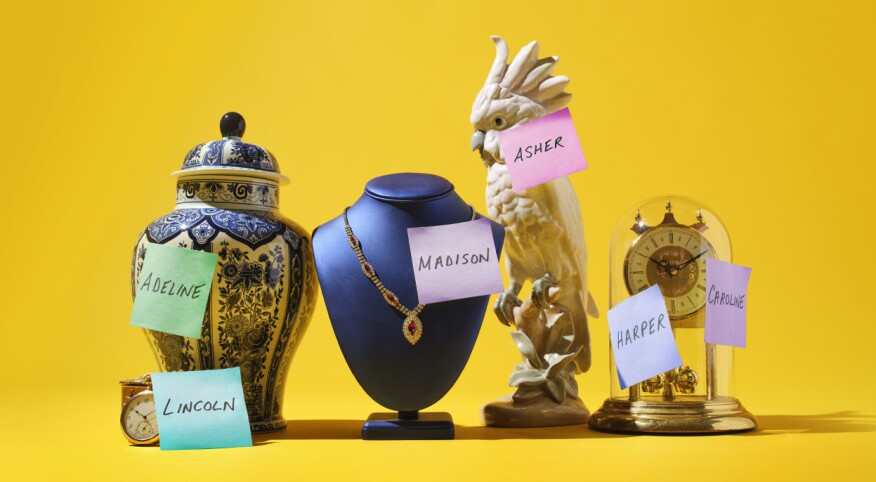Planning for your own death might feel terrifying, or sad, or maudlin, or all of the above. But as The Onion confirmed with its 1997 headline, “World Death Rate Holding Steady at 100 Percent,” we all have to face it.
So, let’s talk about your stuff! Specifically: Upon your death, what will happen to your personal assets? Your paintings, jewelry, books, photo albums and dishware? Who gets what?
If you die without a will, state laws dictate asset disposition (who gets what), generally prioritizing closest blood relatives. But even if you’re fine with your stuff going to your kids, how do they know who gets which item? What’s the mechanism that functions, on the granular level, to determine where each item is to go?
Having recently witnessed three adult siblings tearing each other to shreds over a scratched (but beloved) crystal decanter, I dug into this topic. In an admittedly unscientific study, I asked friends about what they’ve planned for their personal property after they shuffle off this mortal coil. A few gave me blank stares. Plenty of others have either talked to their adult children about this or shared what their own parents did with and for them.
Of course, disposing of your property is a highly personal matter with legal and personal complexities well beyond the scope of this article. Rather, I hope that the ideas I’ve gathered serve as a jumping-off point for your own exploration. Below, I’ve ranked the handful of disposition systems people described from what sounded to me as the least to most successful approaches, and why.
PRE-DEATH
These are approaches folks have taken while they are alive, with an eye toward removing decision-making from their surviving family members and/or friends.
Labels
Quite a few women told me that their moms — I don’t know why this appeared to be a gendered approach — asked them, “What would you like me to leave to you?” Then the property owner stuck Post-its or some kind of label on the back of the item, for posthumous distribution.
Pros: People get to express what matters to them.
Cons: This approach struck me as highly impractical. Post-its and labels can fall off. And what if the donor buys new stuff, or the old stuff breaks? What if two sibs want the same set of earrings? How exactly do you label earrings, anyway?
Lists
One couple I spoke with maintains a spreadsheet of every item they own, assigning each a beneficiary. Rather than making the list part of their wills, they update the sheet twice a year, keep a copy in a safe spot and trust their offspring to follow their wishes.
Pros: The donor maintains complete control over asset disposition.
Cons: Document every item I own? “Serving bowls, patterned, 2. Serving bowls, glass, 1.” I don’t know how much time I have left on this earth, but I’m not spending it chronicling the contents of my closets. Just, no.
POST-DEATH
These asset-disposition ideas kick in after death and require a certain amount of coordination among surviving loved ones.
Lottery
One family told their kids to plan on a posthumous round-robin selection of items. As in: Mom and Dad have died. Beneficiaries gather. First, Campbell chooses a vase. Next, Ellis selects a painting. Then Blake claims the silverware, and back to Campbell again.
Pros: To me, this gives the offspring a nice chance to work together, and hopefully each ends up with items they care about.
Cons: This could be super time-consuming. It also leaves room for real disputes over pricier or particularly coveted items. I mean, what if Campbell chooses the vintage leather chair, right off the bat? And who gets to pick first, anyway? What about the items that aren’t chosen?
List circulation
After the donor’s passing, a surviving beneficiary drafts a list of maybe a dozen items that they think might be most sought-after and circulates it among other friends and/or family. People are free to indicate the item they want most, and to add anything not listed. If there’s no overlap on the most wanted items, disposition follows the list. If there is overlap — everyone wants the painting of the lighthouse — a name is drawn out of a hat.
Pros: Beneficiaries get a say in what items they’d like to have.
Cons: After the first few rounds of reviewing the list, like the “Lottery” approach, there may be a whole lotta items still without new homes. After thinking through these ideas, I decided to bring my adult children into my own decision-making. They opted for the “List Circulation” approach, so in my house, that’s that. I’m glad I spoke to them to make sure they’re on the same page about what to do with my stuff, because they’re the ones who’ll have to sort all this out in the end — together.
Have you started to downsize? How's it going so far? Let us know in the comments below.

Justin Poulsen
Follow Article Topics: Money








